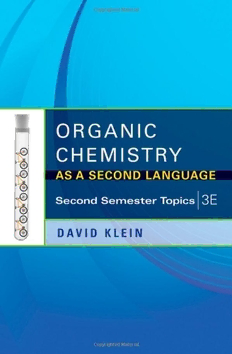
Organic Chemistry as a Second Language: Second Semester Topics PDF
Preview Organic Chemistry as a Second Language: Second Semester Topics
This page intentionally left blank ORGANIC CHEMISTRY AS A SECOND LANGUAGE, 3e This page intentionally left blank ORGANIC CHEMISTRY AS A SECOND LANGUAGE, 3e Second Semester Topics DAVID KLEIN Johns Hopkins University JOHN WILEY & SONS, INC. ASSOCIATE PUBLISHER Petra Recter EDITORIAL ASSISTANT Lauren Stauber MARKETING MANAGER Kristine Ruff SENIOR PRODUCTION EDITOR Sujin Hong; Production Management Services provided by Prepare, Inc. CREATIVE DIRECTOR Harry Nolan SENIOR COVER DESIGNER Wendy Lai COVER CREDITS Background: ©William Hopkins/iStockphoto Test tube: Untitled X-Ray/Nick Veasey/ Getty Images, Inc. Bicycle: Igor Shikov/Shutterstock This book was set in 9/11 Times Roman by Prepare, Inc. and printed and bound by Courier Westford. The cover was printed by Courier Westford. This book is printed on acid-free paper. (cid:2) Founded in 1807, John Wiley & Sons, Inc. has been a valued source of knowledge and understanding for more than 200 years, helping people around the world meet their needs and fulfill their aspirations. Our company is built on a foundation of principles that include responsibility to the communities we serve and where we live and work. In 2008, we launched a Corporate Citizenship Initiative, a global effort to address the environmental, social, economic, and ethical challenges we face in our business. Among the issues we are addressing are carbon impact, paper specifications and procurement, ethical conduct within our business and among our vendors, and community and charitable support. For more information, please visit our website: www.wiley.com/go/citizenship. Copyright ©2012, 2006, 2005 John Wiley & Sons, Inc. All rights reserved. No part of this publication may be reproduced, stored in a retrieval system or transmitted in any form or by any means, electronic, mechanical, photocopying, recording, scanning or otherwise, except as permitted under Section 107 or 108 of the 1976 United States Copyright Act, without either the prior written permission of the Publisher or authorization through payment of the appropriate per-copy fee to the Copyright Clearance Center, Inc., 222 Rosewood Drive, Danvers, MA 01923, website www.copyright.com. Requests to the Publisher for permission should be addressed to the Permissions Department, John Wiley & Sons, Inc., 111 River Street, Hoboken, NJ 07030-5774, (201) 748-6011, fax (201) 748-6008, website www.wiley.com/go/permissions. Evaluation copies are provided to qualified academics and professionals for review purposes only, foruse in their courses during the next academic year. These copies are licensed and may not be soldor transferred to a third party. Upon completion of the review period, please return the evaluation copy to Wiley. Return instructions and a free of charge return mailing label are available at www.wiley.com/go/returnlabel. If you have chosen to adopt this textbook for use in your course, please accept this book as your complimentary desk copy. Outside of the United States, please contact your local sales representative. ISBN 978-1-118-14434-3 Printed in the United States of America 10 9 8 7 6 5 4 3 2 1 CONTENTS CHAPTER 1 IR SPECTROSCOPY 1 1.1 Vibrational Excitation 2 1.2 IR Spectra 3 1.3 Wavenumber 4 1.4 Signal Intensity 9 1.5 Signal Shape 11 1.6 Analyzing an IR Spectrum 19 CHAPTER 2 NMR SPECTROSCOPY 26 2.1 Chemical Equivalence 26 2.2 Chemical Shift (Benchmark Values) 30 2.3 Integration 35 2.4 Multiplicity 39 2.5 Pattern Recognition 41 2.6 Complex Splitting 43 2.7 No Splitting 44 2.8 Hydrogen Deficiency Index (Degrees of Unsaturation) 46 2.9 Analyzing a Proton NMR Spectrum 49 2.10 13C NMR Spectroscopy 53 CHAPTER 3 ELECTROPHILIC AROMATIC SUBSTITUTION 56 3.1 Halogenation and the Role of Lewis Acids 57 3.2 Nitration 61 3.3 Friedel-Crafts Alkylation and Acylation 64 3.4 Sulfonation 72 3.5 Activation and Deactivation 76 3.6 Directing Effects 78 3.7 Identifying Activators and Deactivators 88 3.8 Predicting and Exploiting Steric Effects 98 3.9 Synthesis Strategies 106 v vi CONTENTS CHAPTER 4 NUCLEOPHILIC AROMATIC SUBSTITUTION 112 4.1 Criteria for Nucleophilic Aromatic Substitution 112 4.2 SNAr Mechanism 115 4.3 Elimination-Addition 121 4.4 Mechanism Strategies 126 CHAPTER 5 KETONES AND ALDEHYDES 129 5.1 Preparation of Ketones and Aldehydes 129 5.2 Stability and Reactivity of C¨O Bonds 133 5.3 H-Nucleophiles 135 5.4 O-Nucleophiles 140 5.5 S-Nucleophiles 153 5.6 N-Nucleophiles 155 5.7 C-Nucleophiles 165 5.8 Some Important Exceptions to the Rule 175 5.9 How to Approach Synthesis Problems 180 CHAPTER 6 CARBOXYLIC ACID DERIVATIVES 187 6.1 Reactivity of Carboxylic Acid Derivatives 187 6.2 General Rules 188 6.3 Acid Halides 192 6.4 Acid Anhydrides 201 6.5 Esters 203 6.6 Amides and Nitriles 213 6.7 Synthesis Problems 222 CHAPTER 7 ENOLS AND ENOLATES 231 7.1 Alpha Protons 231 7.2 Keto-Enol Tautomerism 233 7.3 Reactions Involving Enols 238 7.4 Making Enolates 241 7.5 Haloform Reaction 244 7.6 Alkylation of Enolates 247 7.7 Aldol Reactions 252 7.8 Claisen Condensation 259 7.9 Decarboxylation 266 7.10 Michael Reactions 273 CONTENTS vii CHAPTER 8 AMINES 281 8.1 Nucleophilicity and Basicity of Amines 281 8.2 Preparation of Amines through SN2 Reactions 283 8.3 Preparation of Amines through Reductive Amination 287 8.4 Acylation of Amines 291 8.5 Reactions of Amines with Nitrous Acid 295 8.6 Aromatic Diazonium Salts 298 Answer Key 301 Index 345 This page intentionally left blank
